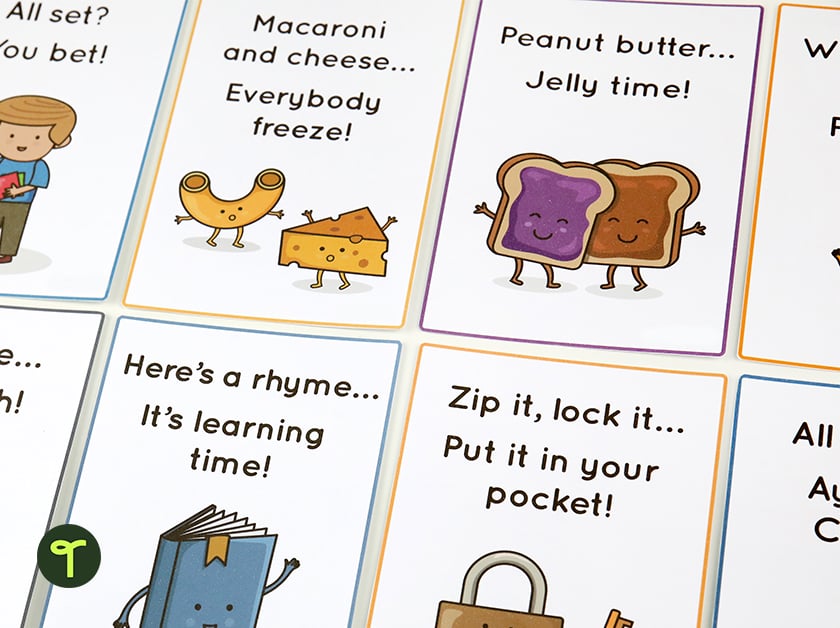

If you’ve struggled with classroom transitions, you’re not alone. Helping students move from one task to another can be a challenge, even for seasoned veteran teachers. But consider this: If you spent just 15 minutes on a classroom transition once a day for an entire school year, you’d lose 45 HOURS of instructional time!
That’s about a week of school lost to transitions! Want to grab that time back? The teachers on the Teach Starter team sat down to take a look at the main three types of transitions and share some of our own tried and true transition strategies that can help you spend more time on teaching (and less time trying to get students back on track!).
Put simply, a classroom transition is a process of moving from one lesson, space, or event to another during the course of the school day. They happen several times a day, and they can be simple or more complicated with a need to change locations and the collecting or swapping of books and equipment.
Transitions can present a challenge for students who see an opportunity to get chatty — or get a little unwieldy — and that can mean a challenge for a teacher to maintain classroom order. But getting this part of the school day down pat is key to classroom management, and fortunately, we’ve got some solid tips from our years in the classroom to help you get on track.
Students will make a lot of transitions throughout a school day — more than you might even realize — but you can easily break them down into three types of transitions:
Seems overly simple? Let’s break it down a little bit more. Here are just some examples of the classroom transitions you might expect to handle throughout the school day — depending on the grade level you teach — which all tie back to those three main types:
Transitions can be incredibly efficient if coordinated effectively. They give students a break by providing them the opportunity to get out of their seats and switch their focus to a new task.
Transitions give students an opportunity to stretch their bodies and take a break from learning — both incredibly important for maintaining concentration throughout the school day.
Classroom transitions can also be used to minimize disruption from restless students when timed appropriately. However, they can also cause excitability if mismanaged. So, now that we know why transitions are important, how do you make sure they’re effective?
Classroom management involves a lot of repetition of the rules and procedures, and that includes transition management. From the first week of school, work to let your students know the signals that you’ll be using when it’s time to make a transition, so they know what they mean and can quickly adapt.
A key to successful transitions is making sure your students feel in control and feel like they are managing their own time, so letting them know what to expect and do puts them in the driver’s seat when it comes to making good choices!

Teach Starter Teacher Tip: Try our Attention-Grabbing Phrase Cards for a fun way to grab student attention! Whenever you’re ready to stop an activity and move on to the next one, simply call out one of the phrases on the cards, and watch them snap to attention!
Getting your students to quickly drop everything and prepare to change activities does take some practice. You need your students to know exactly what to do when you want their attention, and they need to do it fast!
Some cues that members of our teacher team swear by include:
If you are asking students to collect and organize their own supplies, make sure it is in a place they can all easily access without causing a traffic jam. Alternatively, give one of your students the materials manager job for a whole week so there’s no confusion as to who’s carrying what!
Teach Starter Teacher Tip: Print and post a classroom job chart so every student knows who is in charge of what!
Transitions are a great opportunity to get your students up and moving – waking their brains up and giving them a good stretch. Instead of letting the movements get out of control, why not turn it into a little bit of fun?
Playing particular songs when you want your students to complete different transitions is a great way to train them to transition a certain way on cue, and the best part is that they know they only have until the song is up to complete the transition.
Obviously, moving and grooving your body to music isn’t really feasible when you’re moving around the school grounds! So how do you make walking in the hallways interesting and engaging for your students?
There will always be a time and a place for a straight line quietly walking from one classroom to the next, but for those times in between, use our How to walk like a… Instruction Cards!
These fun movement cards encourage your class to concentrate on their walk through the school to ensure they complete the right actions. Their eyes are less likely to wander, their mouths are less likely to chatter, and their minds and bodies will be nicely exercised by the time they reach their destination!
Banner image via shutterstock.com/Prostock-studio